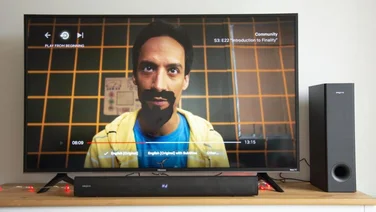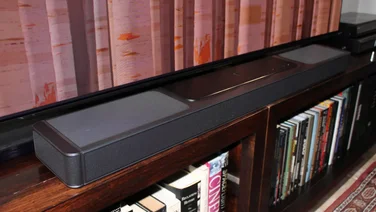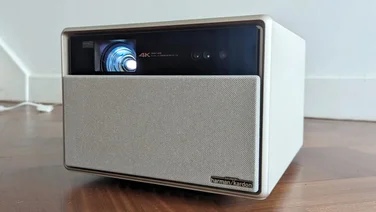To help us provide you with free impartial advice, we may earn a commission if you buy through links on our site. Learn more
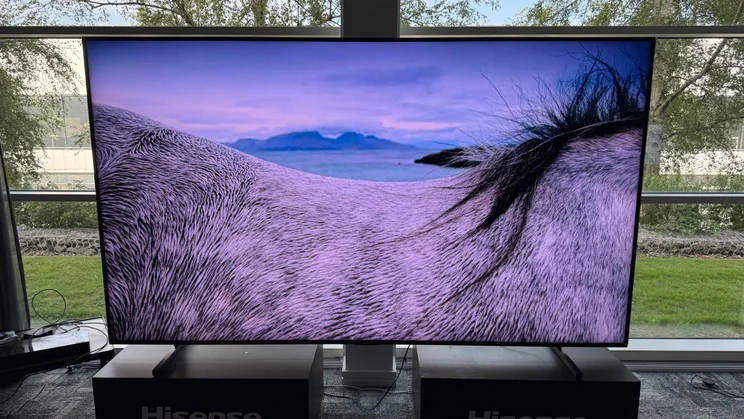
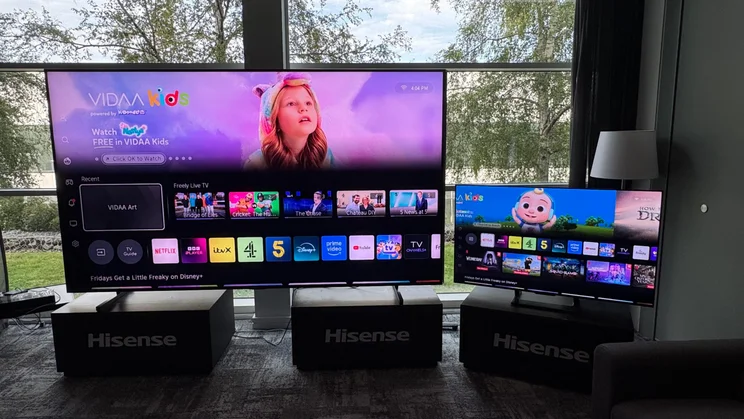
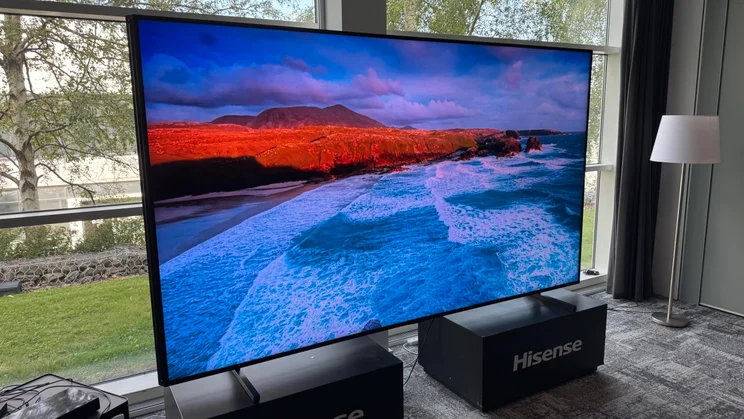
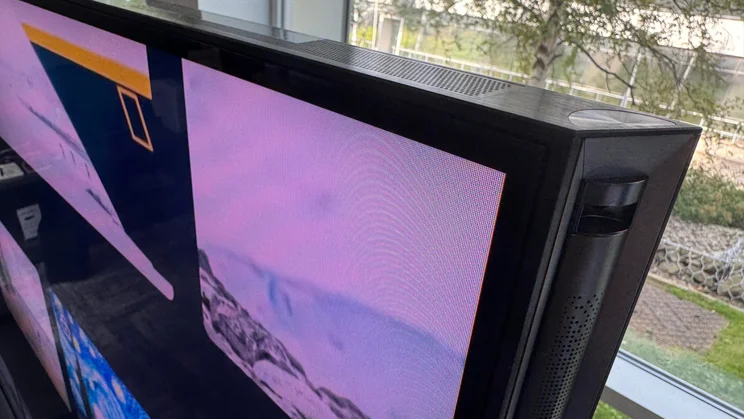
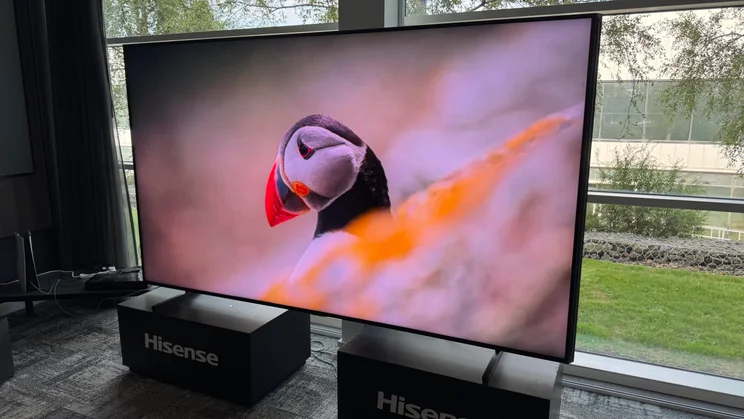
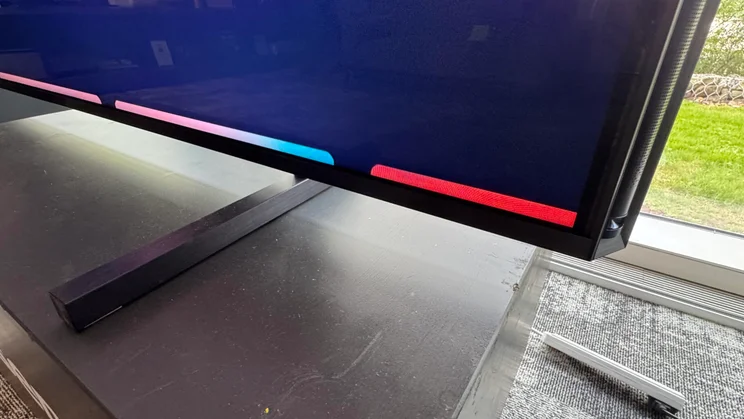
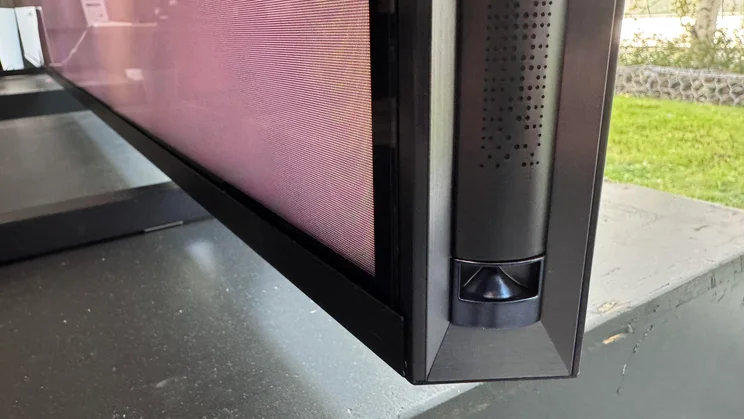
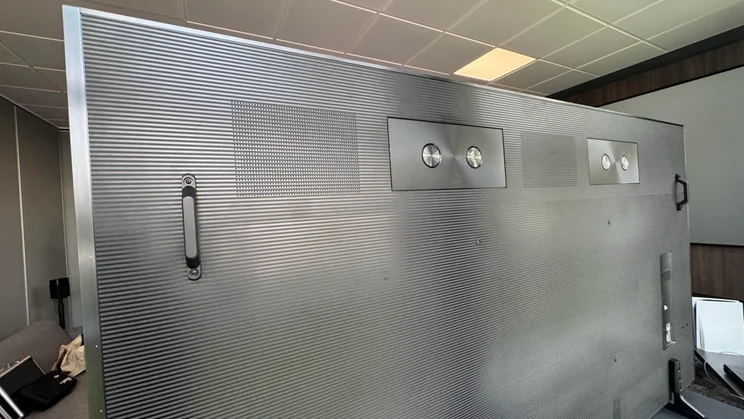
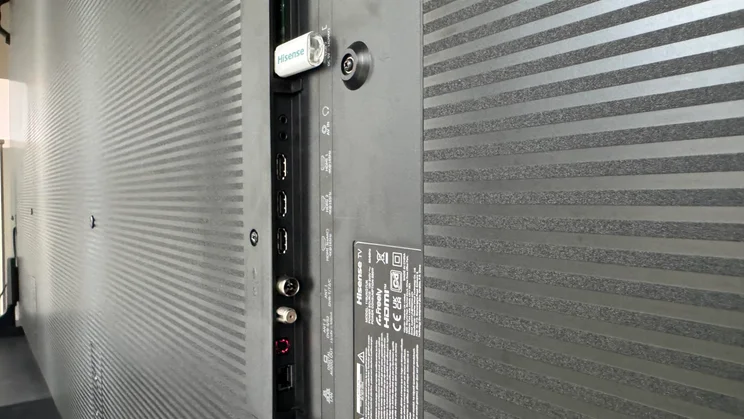

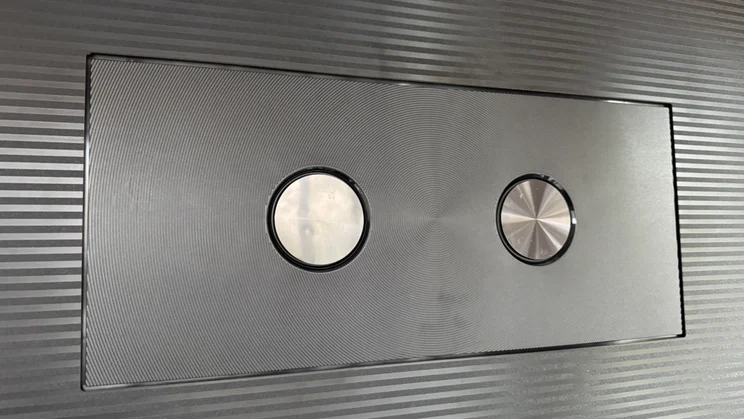
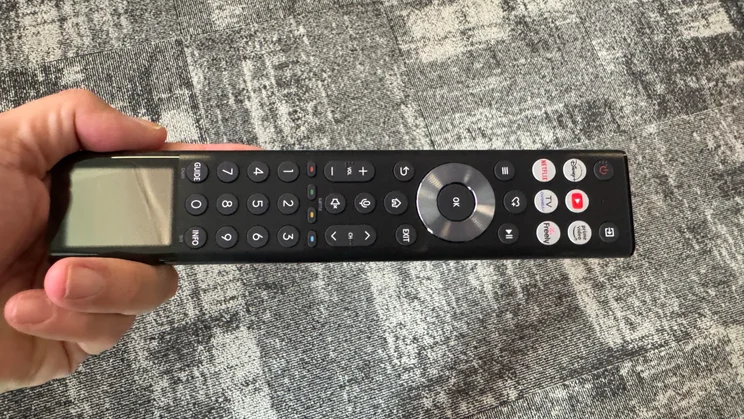
- Groundbreaking colour volume
- Extreme brightness and contrast
- Truly cinematic screen size
- Colours don’t always look right
- Some backlight fogginess
- It’s very expensive
LCD screens that use individual red, green and blue Mini LEDs to produce colour rather than shining white or blue light through colour filters have been shown by several major TV brands in recent months, and the results, especially when it comes to colour, have been spectacular.
In a formidable show of industry strength, Hisense has become the first TV brand to actually bring this exciting new TV technology to market. And all you need to buy it is room for a 116in screen and £24,999 burning a hole in your pocket…
Hisense 116UX review: Key specifications
| Screen sizes available: | 116in 116UX (100in to follow) |
| Panel type: | VA RGB Mini LED with local dimming |
| Resolution: | 4K/UHD (3,840 x 2,160) |
| Refresh rate: | 165Hz |
| HDR formats: | HDR10, HLG, Dolby Vision, HDR10+ |
| Audio enhancement: | 6.2.2-channel sound system (110W), Dolby Atmos and DTS Virtual X decoding |
| HDMI inputs: | 3 x HDMI 2.1 (one eARC) |
| Freeview Play compatibility: | Yes |
| Tuners: | Terrestrial Freeview HD |
| Gaming Features: | 4K@165Hz, Game Mode, Ultra Auto Low Latency Mode, AMD FreeSync Premium Pro VRR support, Game Bar Men |
| Wireless connectivity: | Wi-Fi, Bluetooth 5.3 |
| Smart assistants: | Voice recognition and control built in |
| Smart platform: | VIDAA |
What you need to know
The Hisense 116UX is the first of a new breed of LCD TV that swaps the old white or blue backlight shone through colour filters approach for a system where colour is produced by individual red, green and blue mini LEDs. This new approach opens the door to potentially unprecedented brightness, colour volume and backlight precision.
Hisense leans into the cutting-edge nature of the 116UX by delivering its new technology in a huge 116in screen, backed up by a mammoth claimed brightness of 8,000 nits and a local dimming system delivered across thousands of independently controlled zones.












Although interest in this spectacular-sounding tech will be rendered academic for the vast majority of TV punters by another big 116UX number: its £24,999 price.
Price and competition
Yes, the Hisense 116UX costs £24,999. This puts it miles beyond the financial reach of almost all AV fans – and looks particularly painful when you consider that Hisense sells a very respectable 100in TV, the 100E7NQ, for just £1,299 at the time of writing.
While production lines can now cope with 100in TVs with relative ease, that extra 16 inches the 116UX delivers is anything but current production line-friendly. Then there’s the small matter of that epic screen acreage being illuminated by an all-new, presumably tricky to manufacture RGB Mini LED lighting system capable of supporting a claimed brightness that’s more than twice that delivered by even the most premium ‘regular’ 4K TVs, and a local dimming system that employs thousands of separate zones.
No other RGB Mini LED (or similar) technologies are currently available to buy, so the 116UX’s competition is restricted to other really big TVs. I’ve already mentioned an ultra-cheap 100in Hisense model, but on the more premium side of things, the 97in LG G5 OLED also costs £24,999 (though this doesn’t use the ultra-bright RGB Primary Tandem panel technology found in smaller G5 screen sizes).
Another rival is the £22,595 Bang & Olufsen Beovision Harmony OLED TV, with its huge and powerful integrated sound system. The fact that we’re mentioning a Hisense TV in the same breath as a B&O one speaks for itself on Hisense’s progression from its predominantly budget brand beginnings.
Design, connections and control
Not surprisingly, the single most striking thing about the 116UX’s design is how huge it is. In fact, the extra degree to which it fills your entire field of view more than even a 98in or 100in TV can’t be overstated. If your cinema tastes find you obsessively hunting down the biggest IMAX or Dolby Cinema screens or always booking seats in the first four or five rows of a regular cinema, then the 116UX scratches that same itch at home in a way that only a home cinema projector normally could.
The frame holding all that screen is inevitably pretty hardcore; a heavy-duty, gleaming brushed metallic beast of a thing given added stature and opulence by the presence of integrated speaker tubes that run almost the full height of each side, and evidence of further upfiring speakers in its chunky top edge.












If it’s not hung on a wall, the 116UX sits on simple blade-style feet that support the screen stably enough without distracting you from the TV’s pictures. As if anything could…
The 116UX’s connections include an unusual touch for the TV world: a USB-C style DisplayPort connection. This shows a seriousness about gaming that’s rarely seen outside the professional monitor world – though non PC gamers should note that the inclusion of the DP port sees Hisense limiting the 116UX’s HDMI port count to three. Other ports include an optical digital audio output, a headphone port, a 3.5mm AV input, satellite and terrestrial RF antenna inputs, an Ethernet port, and two USB ports (one v2.0, one v3.0).
The 116UX ships with a suitably premium remote control that boasts a metallic finish and a solar panel built into the bottom of its front edge, as well as a voice control mic button.
Smart TV platform
In the UK, the 116UX’s smart system is built on Hisense’s own VIDAA platform. Which is fine with me, as while it may not be the most glamorous looking smart system around, it’s rich in content, reasonably slick in its responsiveness and one of the most straightforward systems to use and follow.












Global app support includes Prime Video, Disney+, YouTube, Netflix and Apple TV+, while Brits will be delighted to find support for Freely. This system makes it possible to not only live stream (rather than rely on an aerial for) many of the channels available on the Freeview broadcast platform, but also access tens of thousands of hours of archived content from across Freeview’s BBC, ITV, Channel 4 and Channel 5-run channels.
Image quality
It seems almost perverse to be kicking off our analysis of a TV as on the bleeding edge of technology as the Hisense 116UX with standard dynamic range and standard/high definition images. But most of us still spend the majority of our TV viewing time watching this kind of content, so even with a TV that’s likely to be installed in a dedicated movie room, we need to know that it doesn’t make a dog’s dinner of the most common video standards.
Happily, Hisense has equipped the 116UX with a Filmmaker Mode. This gets off to a remarkably disciplined start by basing its SDR pictures around a brightness of barely 85cd/m2. Barely one hundredth of the maximum brightness the screen can produce.
This is clearly the luminance level Hisense thinks helps the 116UX achieve its most accurate colour tones and grayscale for SDR content. However, measurements using Portrait Displays’ Calman Ultimate software and G1 test signal generator, together with a Klein 10-A colour meter, produce results that aren’t as bang on Rec 709 standards as many other premium TVs we’ve seen. Two-point and multipoint grayscale tests in particular score Delta E 2000 average errors of 8.6 and 14.2, where we ideally look for numbers under three.












The out-of-the-box Filmmaker Mode fares better with colour, turning in Delta E 2000 average errors of 4.5 for Calman Ultimate’s colour point and saturation sweep tests, and 3.1 with a luminance sweep analysis. The set also provides extensive picture management tools that a professional calibrator could use to try and improve how the 116UX handles its light in the relatively constrained world of SDR video.
Actually watching the 116UX in SDR Filmmaker Mode throws up the occasional colour tone that doesn’t feel totally natural, and the occasional slightly cloudy, noisy area in dark but textured parts of an image. Filmmaker Mode SDR pictures look very good for the most part, though. Black levels are mostly very impressive for such a huge TV, and backlight blooming and clouding are generally very well handled by the TV’s 3,584 separately controlled local dimming zones. Colours look rich and full by usual Filmmaker Mode standards, but also contain enough tone subtlety to avoid looking plasticky or flat.
The 116UX’s upscaling of HD and SD content to the screen’s 4K resolution isn’t quite as effective as I’d have liked it to be with such an unforgivingly huge screen to fill. Grain or source noise can look a bit exaggerated, like a fizzy filter over the picture. You can soften the impact of this with the TV’s noise reduction and sharpness tools, but the bottom line is that Hisense’s processing seemingly isn’t quite as good at detecting and dealing with source noise before applying its upscaling as some of the world’s best big-screen upscaling engines.












The 116UX’s Standard mode ramps the brightness and colour up substantially, as you would expect. For me, this results in pictures that actually feel a bit more comfortable for the 116UX’s extreme panel to handle than the Filmmaker Mode ones, even if they inevitably measure less accurately than the Filmmaker Mode.
That said, the DeltaE 2000 average error values of between 10 and 20 across most of the Calman Ultimate tests aren’t actually huge by Standard mode settings, and the 395cd/m2 white level the Standard preset builds its pictures around still shows an impressive degree of constraint on Hisense’s part. It gives you enough extra brightness to make SDR images enjoyable in a bright room without pushing things so far that everything starts to look too hyper-real.
The post upscaling noise with HD and SD sources actually looks stronger in Standard mode than it does Filmmaker Mode, though, so in the end, while I was impressed overall by how the 116UX dealt with HD, SD and SDR stuff, it is a screen that you should only invest in if you have the secondary source gear to ensure it’s fed as much 4K and HDR content as possible.
HDR performance
HDR and its (usually) attendant wider colour range is, of course, what the Hisense 116UX is really all about. Looking at colour first, Calman Ultimate tests of the Standard picture preset show the 116UX to be capable of covering a monumental 141.7% of the DCI-P3 colour spectrum used for most HDR mastering, as well as 93.27% of the vast BT2020 gamut currently used as a ‘container’ for DCI-P3, but which some experts think may become a de facto standard in the future.
These figures both break new ground for LCD TV technology – and as the screen can retain its rich saturations at its highest brightness levels, the colour volumes it can attain are again unprecedented.
Those highest brightness levels are a sight to behold. In the TV’s Dynamic preset with its AI Brightness Boost feature engaged, I recorded 8,440cd/m2 on a 5% HDR test window, a figure that exceeds Hisense’s own 8,000cd/m2 claims. Whoop. But now cue the reality check… the AI Brightness Boost feature required to achieve this figure isn’t active by default in any of the TV’s picture presets. Not even the punchiest Dynamic one.
This suggests that Hisense believes there are issues with the feature, and I certainly experienced a few during testing. While there are moments where your jaw will involuntarily fall open at the incredible intensity and brightness of some highlights of HDR images, Brightness Boost causes too many issues for comfort, making bold colours look like they’re glowing quite unnaturally and making some bright peaks – especially on faces – appear too stark and clipped of detail.












With AI Brightness Boost turned off to get a more natural and consistent picture, the 116UX peaks – this time on a 10% window – at 4,700cd/m2 in Standard mode, and 4,440cd/m2 in Filmmaker Mode. These are still monumentally high values for the domestic TV world, and when writ as large as they are across a 116in screen and fed into ground-breakingly far-reaching RGB Mini-LED-inspired colours, they result in the flat-out most dazzling and spectacular pictures I’ve seen in 30 years of testing TVs.
With good quality 4K HDR sources, we’re talking a ‘wow’ a minute experience, honestly. Especially as the screen manages to retain more than 900cd/m2 of brightness even when it’s completely flooded with bright HDR image content, while colours are delivered with remarkable definition and purity.
While the 116UX’s extraordinary brightness and colour reach not surprisingly grab your attention first, it doesn’t take long to realise that part of the reason images look so phenomenally intense and vibrant is because all that brightness is being delivered alongside really deep, rich black levels. A major reminder of the huge number of dimming zones the 116UX deploys to try and control all of its prodigious light and colour.
Sharpness with native 4K content is much better, predictably, than it was with upscaled HD sources; not least because the slightly exaggerated noise issues with HD and SD content melt away when the content pixel count matches that of the screen.












Motion can look a little juddery with 24p HDR content, partly due to the screen’s extreme brightness, but this judder reduces in impact if you switch from the punchy Standard preset to the less bright Movie or Filmmaker Mode presets. A couple of the mildest motion processing options Hisense provides deliver quite clean and effective judder-reduction results, too.
While I would encourage most 116UX owners to use its Standard preset for most of the time, to enjoy more benefits of its expensive screen, its HDR Filmmaker Mode actually delivers a more accurate performance than its SDR one. In fact, Calman Ultimate tests gave Delta E 2000 Average error scores under three across all of my regular ColorMatch, Colorchecker, BT2020 Sweep and P3 Sweep tests.
The Filmmaker Mode throws up a few issues during subjective viewing, though. Some colour tones just don’t look quite right; deep greens, for instance, tend to take on a rather brown tone. Some tones, again most often in relatively dark scenes, feel a bit too dominant, too, while some heavily saturated dark shots, such as the dusk scene where Moses throws his sword into the sea in Exodus: Gods and Kings, exhibit incorrectly differing colour intensity levels in different parts of the screen.
The 116UX’s pictures look notably better with the HDR10+ and, especially, Dolby Vision premium HDR formats, which suggests that Hisense’s own dynamic tone mapping isn’t quite as perfectly worked out for the extreme talents of its new TV as it might have been.












The backlight system sometimes generates a sudden, mildly foggy look during very dark sequences, too, as well as a slight dirty screen effect in Filmmaker Mode during camera pans in mid-dark scenes.
Some colour tones, especially relatively pure reds, greens and blues, feel strangely flat, even in Standard mode, despite the extremes of light flooding into them, while dark scenes sometimes lose a little shadow detail. A Dark Detail feature brings this missing detail back, but can also expose too much shadow detail information, including unwanted noise. A Dynamic Colour feature ramps up general saturations, but doesn’t fix the slightly off look to some colour tones.
A couple of smaller points are that the screen is a little reflective of bright objects in the room, and that you see more backlight blooming if you have to watch the screen from much of an angle.
I should conclude by saying that the 116UX convincingly looks and acts the part of an ultra-premium game-changing TV most of the time. But when a TV costs £24,999, it’s necessary to be forensic about the niggles as well as the good stuff.
To test the Hisense 116UX, I used Portrait Displays Calman colour calibration software.
Gaming
Roaming around your favourite gaming worlds on a 116in screen capable of pumping out many thousands of nits of brightness and unprecedentedly gargantuan colour gamuts is almost obscenely fun. Life-sized (actually bigger) Assassin’s Creed? Don’t mind if I do.
The screen delivers well on its high and variable refresh rate promises, delivering faster titles like Call of Duty with impressive fluidity that merely enhances the immersiveness of gaming on this sort of scale. It gets lag down to a respectable 14.6ms at 60Hz, and around half that at 120Hz, which further enhances your involvement in what you’re playing.












The TV has the features gamers will be looking for alongside its super-impressive performance. Its ability to reach 165Hz refresh rates with variable refresh rates (including AMD FreeSync Premium Pro) over all three HDMI inputs is excellent, and some parts of the PC world will be very pleased to find a DisplayPort input – something that’s a seriously rare discovery in the TV business.
The 116UX also follows other Hisense TVs in carrying a dedicated game menu that comes up when it’s running a game source.
Sound quality
The premium Devialet-bolstered sound system built into the 116UX’s ample bodywork creates a large but convincing soundstage that includes a powerful, compelling and consistent sense of sound coming from the actual screen, rather than everything just sounding like it’s coming from the left, right and upper edges.
The general tone of the sound is clean and dynamic, almost hi-fi grade at times, and the mid-range has a broad, open quality to it that ensures even dense soundtracks don’t appear cramped or thin. There’s enough headroom in the speakers to shift up numerous gears of power and expansion as loud scenes increase in intensity, while dialogue is consistently clear and intelligible, as well as locked to the screen. In short, the sound typically feels as big as the screen, and that’s saying something.
While the 116UX’s speakers cope well with moderate bass levels and punchy percussive bass sounds, though, they can struggle with sustained, long, deep rumbles, presenting them with an accompaniment of distracting crackling interference.












Other issues find the sound lacking a little forward presence, and an upper limit to how much soundmix density the speakers can cope with. Now and then, a particularly heavy moment will come along in a soundtrack that levels off too early rather than continuing to expand and grow as the mix wants it to.
Overall, the 116UX’s sound does enough to keep its pictures respectable company without entering into quite the same ground-breaking territory.
Verdict
The Hisense 116UX lives up to its billing as a next-gen TV. Its colour (especially in volume terms) is like nothing we’ve seen before, its brightness is the most extreme we’ve seen besides Hisense’s own 10,000-nit 110UXN, and its screen is the biggest we’ve ever tested. All of which results in an unforgettable viewing experience.
Hisense occasionally seems to be struggling to fully unlock or, more commonly, control the capabilities of its new TV beast, though. And with its £24,999 asking price, Hisense’s new RGB Mini LED screen will remain an interesting hint at things to come rather than something remotely likely to turn up in the homes of most AV fans.


